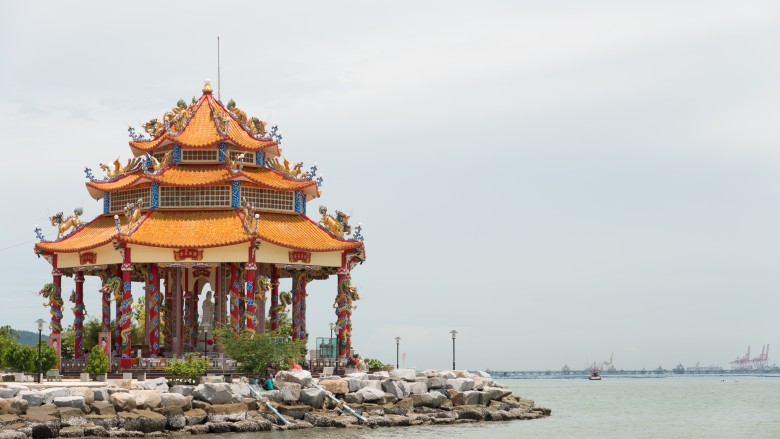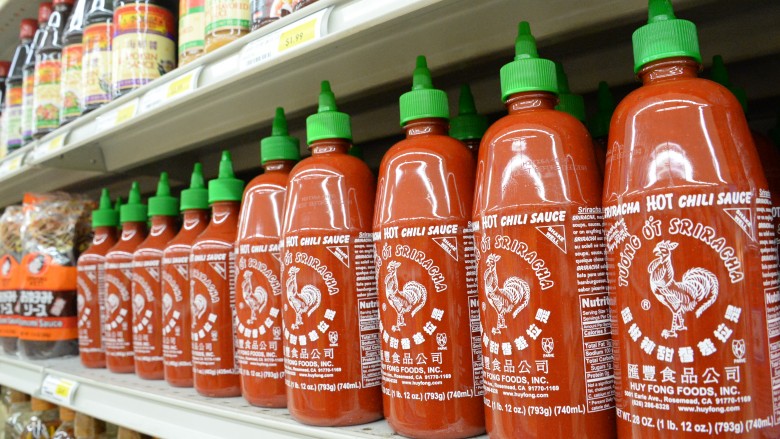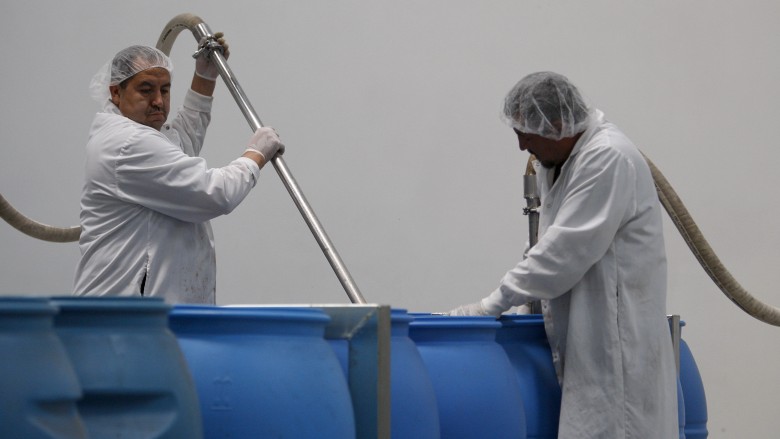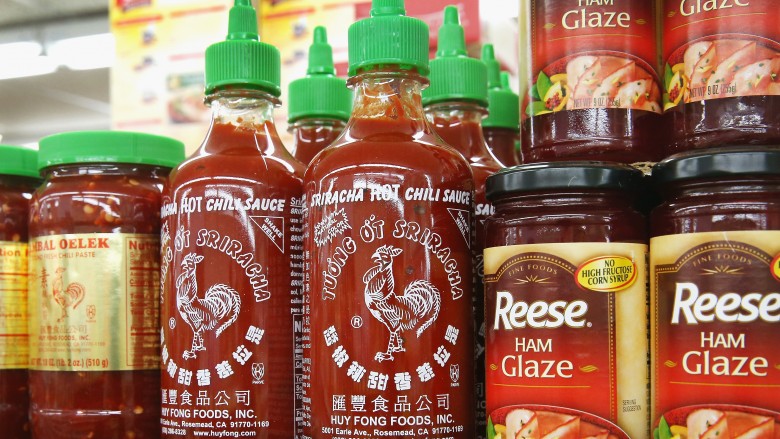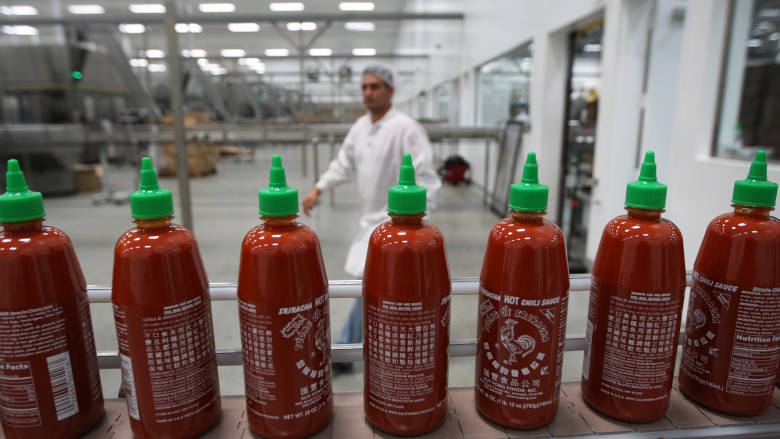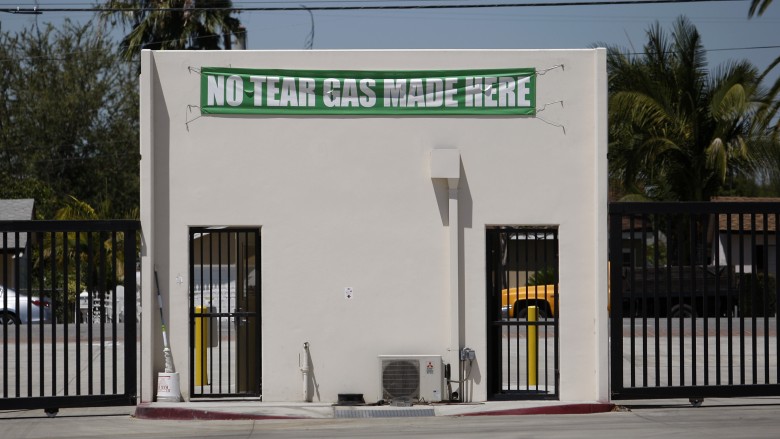The Untold Truth Of Sriracha
Ah, Sriracha, the wonder sauce. From relative obscurity, this spicy "rooster sauce" was propelled into the mass consciousness over the last decade, becoming a mainstay of American cuisine. A century from now, films set in this time period won't fail to include the distinctive bottle in every meal scene, a cruel taunt to the moss-eaters of the 22nd century. But for now we have our Sriracha, which goes with almost anything. This wunderkind sauce has a long and interesting history, and more than a few secrets.
The original is Thai
While the Sriracha sauce most familiar to Americans is a Vietnamese-American invention, the roots of the sauce actually lie in Thailand. In the 1930s, a woman named Thanom Chakkapak from the seaside community of Sri Racha invented a hot sauce intended as a cocktail sauce for seafood, which she called Sriraja Panich. Her family and friends encouraged her to take it commercial, and it became a huge success throughout the country.
The sauce is quite different from American Sriracha. The Thai version is made with garlic, prik chi faa peppers, vinegar, sugar, and salt which is fermented in casks for at least three months before being bottled, and has a more liquid consistency only barely thicker than Tabasco. It is popular with fish, fried food, seafood and khai jiao wok-fried omelette, as well as mixed into pad thai or combined with tamarind leaf for a tasty raw oyster shooter.
American Sriracha is little known in Thailand, and many Thais who try it find it excessively spicy, overpowering, and alien to their tastes, as well as packed with MSG, preservatives, and thickeners. They look askance at American habits of covering food with Sriracha until it completely takes over the flavor. However, many Thais who have lived overseas admit to learning to like the American sauce on its own merits, and hope to use the popularity of American Sriracha to help popularize the traditional Thai version of the sauce in the U.S.
It was never trademarked
Perhaps one of the reasons the Sriracha name was able to blow up so quickly was the fact that David Tran never trademarked his product, allowing companies like Heinz, Frito-Lay, Subway, Jack in the Box, Taco Bell, and Pizza Hut to use the name to flog off their own products. Sriracha sauces are now being sold by rival companies like Tabasco, Frank's Red Hot, Kikkoman, and Lee Kum Kee, and the flavor has been incorporated into everything from candy to soda to pizza sauce. Business consultants, lawyers, and rivals have been mystified by Tran's chronic disinterest in protecting his brand name. Whether there's some residual guilt toward the Thai original is up for the reader to decide.
According to his deputy Donna Lam, David Tran isn't too worried about it all. "David is fine with that since in some indirect way, we will still reap the benefit of the word 'Sriracha' being used. We seem to be the best-known Sriracha out there, and everyone seems to use our brand as the gold standard."
Even more pernicious are those faux Srirachas shameless enough to ape the very design of the Huy Fong bottles, substituting the green cap for a variety of colors and the rooster design for tigers, mountains, pyramids, or unicorns. Cool Material determined in a taste test that the Huy Fong brand variety still reigned supreme, but be careful out there. Remember: make sure the cap is green and grooved with a thin ring at the bottom, and check the label has been nicely laser etched so it doesn't blur. And obviously, if it doesn't have a rooster on the bottle you're crowing up the wrong tree.
It's (probably) not that good for you
Hot sauce has great benefits, thanks to the antioxidant, anti-inflammatory and anticarcinogenic effects of capsaicin. But Sriracha isn't exactly the best hot sauce choice from a health perspective. Sriracha contains 1 gram of sugar and 100 milligrams of sodium per teaspoon, compared to 1.2 grams and 52 milligrams respectively for ketchup. This isn't such a problem when kept within the recommended tablespoon serving, but considering how common it is to smother food in Sriracha, that sugar and salt can add up quite quickly. This also makes it an unwise choice to use in cooking, despite the convenience.
This is also a problem if you're a spice fiend looking for your fix. Sriracha ranks at only 2,200 Scoville units, while the jalapenos it comes from clock in at 2,500 to 8,000 Scoville units. Perhaps it is better to treat Sriracha as a sometimes sauce and keep other healthier options at hand, such as Cholula and Tabasco, which both have zero calories and lower sodium levels.
There are some dissenters, however. After all, to exceed the daily recommended dose of sugar in a day you'd need to drink half a bottle of Sriracha, which is rare outside of misguided YouTube challenges. New Mexico State University's Willis Fedio, who analyzes chili-based foods, is one such defender, saying "Added sugars aren't such a big deal, especially in a condiment." While organic health chain Mom's Organic banned Sriracha from its shelves due to the potassium sorbate and sodium bisulfite additives, neither of them are really a big deal unless you happen to have an allergy to potassium or sulfites.
Sriracha in space
Space does weird things to the sense of taste. While some astronauts claim space makes food taste better, more complain of a reduction in flavor. This is largely due to the effect of microgravity, which causes the body's fluids to re-align and can cause nasal congestion inhibiting the intake of odor molecules into receptors, reducing perceived taste by up to 70 percent. This congestion clears up after a couple of weeks but is further compounded by the stinky reality of life in a space station: body odor and equipment exhaust circulating through recycled air can create such a muddled and unpleasant olfactory environment, it becomes difficult to discern new smells.
Hot sauce is thus popular with astronauts, as spicy food registered more on the trigeminal nerve in the mouth and other areas than by the nose. NASA has sent Sriracha to the International Space Station for several years now, where it joins other flavor enhancers like wasabi, horseradish, and Tabasco. Huy Fong Foods is proud of this; visitors to the Huy Fong factory lobby are greeted by a photo of the International Space Station showing two astronauts having a meal, a bottle of Sriracha floating in zero gravity with them. This would possibly make it the most expensive bottle of Sriracha in the universe when you take shipping into account: around $4,729 for the 1 pound payload of hot sauce. Worth it.
Wartime Vietnam
The Sriracha sauce most Americans are familiar was first developed by David Tran, who from a young age dreamed of creating an Asian equivalent to American ketchup. The Tran family owned land north of Saigon and grew peppers but found the market saturated and bad for pepper sales due to the instability of the Vietnam War. The family made and sold chili sauce instead. The sauces were sold in repurposed Gerber baby food jars sourced from U.S. servicemen. Tran had no formal name for his sauces, but he decorated the cap for each jar with his Eastern astrological sign, a rooster. The most popular sauce then was an oil-based chili sauce flavored with ginger-like galangal, intended for dipping beef from pho but at the time more popular as a condiment for roasted dog.
Tran's first endeavor was only a mild success: there was a lot of competition from other sauces and the use of fresh chili was much more popular. Things became much more difficult for the family after Saigon fell in 1975: the communist authorities disapproved of merchant capitalists and Sino-Vietnamese alike. Vietnamese Chinese were viewed with suspicion for their wealth and potentially divided loyalties, particularly as relations between China and Vietnam became strained. In the end, David Tran converted his wealth into gold in order to get his family out of the country. However, he later told the Los Angeles Magazine that "if the country had not changed, I would still be there. It is a very beautiful place, very pleasant to live."
Origin of a name
The company that would ultimately manufacture David Tran's famous Sriracha, Huy Fong Foods, has a historical basis to its etymology. Tran escaped Vietnam in December 1979 aboard the Taiwanese-owned Panamanian-flagged freighter Huey Fong, which picked the refugees up from small boats off the coast of Vietnam and ended up moored off Hong Kong when the refugees aboard were refused entry. Hong Kong authorities ordered the ship to continue onto its designated port of call in Kaohsiung but the captain refused, claiming that one of the refugees had threatened to kill him if he continued on toward Taiwan, which had rejected resettling ethnic Chinese refugees from Vietnam.
In January 1979, the British government came to an agreement with the United Nations designating Hong Kong as a "first port of refuge" before resettlement elsewhere, and David Tran and his family spent the next year in a refugee camp before being resettled in the United States. The Hong Kong authorities became suspicious after interviewing interned refugees and discovering a hidden cache of gold in the engine room. The crew of the Huey Fong was arrested and pleaded guilty to the crime of defrauding the Hong Kong government by illegally bringing in the refugees, whom the conspirators had called "frozen ducks."
Despite this ignominious background, David Tran would later commemorate the ship which ultimately brought him out of communist Vietnam by naming his company Huy Fong, based on the Vietnamese pronunciation of the name of the vessel.
The birth of a company
David Tran and his family arrived in Boston and quickly moved to California after Tran called his brother-in-law who lived there to confirm that chili peppers were grown there. He claims to have sampled a chili sauce from Los Angeles' Chinatown and decided he could make a much better sauce, and he noted that prepared foods were more popular in the United States than they had been in his home country. After being rejected for a bank loan, Tran took the risk of using his family savings to finance the business, opening a 2,500-square-foot space in Chinatown in February 1980 to make chili sauce.
The first sauce produced by Huy Fong was Thai-style pepper sate sauce, which was made in a 50-gallon mixer and delivered to Chinatown restaurants and shops. He developed a number of sauces to satisfy local demand: chili garlic, sambal oelek (ground fresh chili paste), and sambal badjak (onion-flavored chili paste). But Tran wasn't satisfied, later telling the New York Times, "After I came to Los Angeles, I remember seeing Heinz 57 ketchup and thinking: 'The 1984 Olympics are coming. How about I come up with a Tran 84, something I can sell to everyone?' " In 1984 he developed his most famous sauce from fresh red jalapenos, garlic, sugar, salt, and vinegar: Sriracha, this time pronounced "sri-RA-sha."
As for the now-iconic design, Tran still wanted to use the rooster label from his first venture in Vietnam but desired a larger and sharper image, so he commissioned a Chinatown street artist to design the symbol we know today. Sadly, Tran cannot remember the name of the artist who designed the image, and his own sketch was lost. Tran told Modern Farmer, "I never thought that I'd be successful so I didn't keep any of my souvenirs – I don't even have a picture."
How Sriracha hit the big time
David Tran never advertised his sauces in a traditional way, preferring to allow word of mouth to do the work for him. He hoped the sauce would catch on in Vietnamese pho shops in California and had no ambitions of mainstream success. Indeed, there was a logistical logic behind Tran's reluctance to advertise: the supply of sriracha is dependent on the limited supply of fresh chili peppers.
Still, the sauce began to attract mainstream attention in the 1990s as it made appearances at Asian restaurants around the country, and interest in the sauce began to slowly increase at the turn of the century. In many ways, Sriracha benefited from the ever-increasing popularity of hot sauce in the United States, which grew 150 percent between 2000 and 2015, but Sriracha's cult following was more intense than those of rival hot sauces. P.F. Chang's was an early adopter, incorporating the sauce into its offerings as early as 2000, and it was later picked up by Applebee's, L.A.'s Kogi Korean taco trucks, and chefs throughout the country. Bon Appétit magazine named Sriracha Ingredient of the Year in 2010 and others soon followed, including Martha Stewart Living, The Food Network, and even webcomic The Oatmeal, which in 2011 stoked the flames with a love letter to the "TASTY FIRESTORM!" By 2013, the once-obscure sauce had become mainstream.
Fake sauce caper
In 2005, Huy Fong Foods began receiving complaints from East Coast consumers of a decline in quality of their beloved rooster sauce, believing the company had changed the ingredients or watered it down. The company requested those affected send the bottles back, and soon discovered they were knockoffs with errors in the packaging and distinctly inferior contents. The company sought injunctions against retailers and distributors to stop them selling the counterfeit sauce but had a hard time tracking down the source of the fake sauce.
The plot thickened when the company received a call from a security guard complaining of ten pallets of goods marked with Hoy Fung's address being left for days in a parking lot in the City of Industry. A Huy Fong employee was sent to investigate and discovered boxes containing imitations of its entire product line, some of which were packed inside imitation Huy Fong boxes being packed inside cartons reading "Made in China." David Tran himself visited the lot the next day to find two men loading the boxes into the dumpster of a carting company. They were working so quickly one of the men was covered in hot sauce.
The carting company stated it had been hired to dispose of 13 tons of "municipal solid waste" by a client, who paid by an easily traceable check. The source of the contraband was tracked down to an electronics warehouse owner named Yak Szeto, who was raided and arrested by police, eventually pleading guilty to possession of contraband after knockoff printer cartridges were found in his facility. Why this hasn't been adapted by Hollywood is beyond me.
War with Irwindale
Huy Fong Foods opened a new factory in Irwindale to meet growing global demand in 2012, but trouble soon started brewing with local complaints about an offensive odor emanating from the facility. After residents complained that the smell from the plant was making their eyes water and throats burn, the city of Irwindale filed suit against the company in Los Angeles County Superior Court in 2013, declaring the odor to be a public nuisance. The disagreement dragged out over months, during which David Tran compared the local government to the communist Vietnam and draped a banner in front of the factory reading "NO TEAR GAS MADE HERE." In February 2014, the company opened the facility to the public for visitors to come and smell for themselves. A consulting firm for the city argued that odors can vary in intensity over the course of a day and affect individuals in different ways, causing respiratory problems for some while prompting mere cravings in others. The city eventually dropped the lawsuit in May 2014, claiming to have been satisfied with the company's promise to resolve the issue.
Trouble sprang up again in 2015 when the city again sued the company for over $400,000 in unpaid fees. The action alleged that the city entered into an agreement with Huy Fong in 2010 to pay $250,000 every year to the municipality as a payment in lieu of taxes. The first three payments were made from 2012 to 2014, but the company failed to make its 2015 payment, even after acquiring a deferral until November of that year. Instead the company sent a letter informing the city no further "contributions" would be made until the issues with local residents who complained about the odor from the factory had been sorted out. According to Tran himself: "From the very beginning, I offered to contribute $250,000 per year for 10 years for the benefit of the Irwindale community through the city of Irwindale. But because we had this odor issue where all five of the City Council members unanimously declared us a public nuisance, without real basis, I feel that Huy Fong Foods is being treated unfairly, so I stop the contributions."
In 2016, the company counter-sued the city claiming the initial agreement was not with Huy Fong Foods Ltd. at all but rather with Huy Fong Irwindale LLC, a separate entity, and that the fees claimed by the city were invalid. The company said it nevertheless paid the contributions in good faith for the well-being of the community until the city embarked on a "campaign of harassment." The company also asked that the $750,000 in contributions already paid to the city be returned. Let's just hope everything gets worked out before store shelves run empty.

